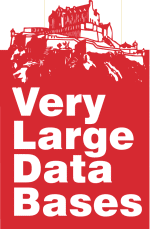| 25th
International Conference on Very Large Databases Edinburgh - Scotland - UK 7th - 10th September 1999 |

|
Invited Talks
Keynote Address - Dr Rudolf Munz, Program
Director DBMS-Technology, SAP AG
Usage Scenarios for
DBMS
Wednesday 8th September, 11:00-12:30,
Pentland Auditorium
Session Chair: Michael Brodie
DBMS grew up in an OLTP (Online Transaction Processing) environment. During the last decade research and development tried to extend the usability of DBMS to new application areas: data warehouses, mobile applications, document warehouses, object-oriented applications, and XML servers. This was either done by extending the existing SQL DBMS technology or by introducing new OO-DBMS technology.
Different usage scenarios and their requirements for DBMS are presented in this talk and the solutions SAP decided to use in its applications portfolio are evaluated. The unique requirements of different application areas are unlikely to be fulfilled by one single and universal DBMS technology. Special-purpose DBMS with emphasis on the requirements of a particular usage scenario and its data management problems are needed.
Rudolf Munz studied Computer Science at the Universities of Stuttgart and Karlsruhe, got his doctoral degree from University of Stuttgart and headed a research project on distributed databases at Technical University of Berlin. He was responsible for a DBMS product development at Nixdorf Computer AG, Siemens Nixdorf Informationssysteme AG, and Software AG which was sold under the names DDB/4 and ADABAS D. Within SAP AG, Rudolf Munz is a Program Director and in charge of the development of SAP DB, the ABAP language, the SAP GUI and other aspects of SAP's Basis technology
Keynote Address - Steve DeRose,
Chief Scientist, Inso Corporation, Adjunct Associate Professor, Brown
University, Scholarly Technology Group
What Do Those Weird XML
Types Want, Anyway?
Friday 10th September, 11:00-12:30,
Pentland Auditorium
Session Chair: Stan Zdonik
Steve DeRose's research with document structures began in 1979 when he joined the FRESS hypermedia project as an undergraduate at Brown University. His combined interests in natural language processing, classical and Biblical literature, and document processing have kept him near the centre of the emergence of documents as machine-accessible structures. In 1989 he completed his PhD in Computational Linguistics, working with the developers of the first large-scale natural language corpus on dynamic programming approaches to assigning parts of speech via Hidden Markov Models. After graduate school he co-founded Electronic Book Technologies (EBT), whose DynaText system became the leading software for delivering and searching big SGML documents: from aircraft, telecommunications, and power industry manuals to poetry collections.
EBT is now part of Inso Corporation. In his role as Chief Scientist at Inso and at Brown's Scholarly Technology Group, he is active in a wide range of standards efforts centering on document representation, hypertext, metadata, and query languages. He is a charter member of the XML Working Group and coeditor of the W3C XLink and XPointer specifications. He is a frequent speaker in industry and academe, and has written many papers, two books and three patents. He now lives, works and ice-skates in Maryland.
10 Year Award Talk - C. Mohan,
IBM Almaden Research Center
Repeating History
Beyond ARIES
Tuesday 7th September, 09:30-10:30,
Pentland Auditorium
Session Chair: Malcolm Atkinson
The programme committee is pleased to recognise the significant contribution of the VLDB'89 paper "Exploiting the ARIES recovery algorithms for Nested Transactions" Mohan C. & Rothermel K. by awarding it the prestigious Ten Year Paper Award.
The techniques of logical log records, log compensation records and re-establishing the state prior to a crash, before undoing the work of transactions that do not complete, has proved to be of wide-ranging importance and significance, for instance, in enhancing the robustness of Lotus Notes as well as many major DBMS.
We are delighted that the creator of ARIES, C. Mohan will present an invited talk "Repeating History Beyond ARIES" which will explain why ARIES has had such an impact, and will examine the way ahead for durable and recoverable systems.
This talk reviews the history of logging and recovery in DBMSs and explains what led to the development of the original ARIES recovery method and briefly introduces the various recovery and concurrency control methods in the ARIES family. In ARIES, the concept of repeating history turned out to be an important paradigm. Examining where transaction management is headed in the world of the Internet, history has repeated itself in the sense of requirements that used to be considered significant in the mainframe world (e.g., performance, availability) are now becoming important requirements in the broader information technology community as well. The talk also discusses some of the recent developments affecting the transaction management area and what these mean for the future.
Dr. C. Mohan joined IBM Almaden Research Center in 1981. He was named an IBM Fellow in 1997 for being recognised worldwide as a leading innovator in transaction management. He received the 1996 ACM SIGMOD Innovations Award in recognition of his innovative contributions to the development and use of database systems. He has received from IBM 1 Corporate and 7 Outstanding Innovation Awards. He is an IBM Master Inventor with 32 patents. His research results are implemented in numerous IBM and non-IBM products and prototypes. He is the primary inventor of the ARIES family of recovery and locking methods, and the industry-standard Presumed Abort commit protocol. He was Program Chair for VLDB96 and HPTS87. He is an editor of VLDB Journal, and Distributed and Parallel Databases - An International Journal. He received a BTech (1977) from IIT Madras and a PhD (1981) from UT Austin.
![]()